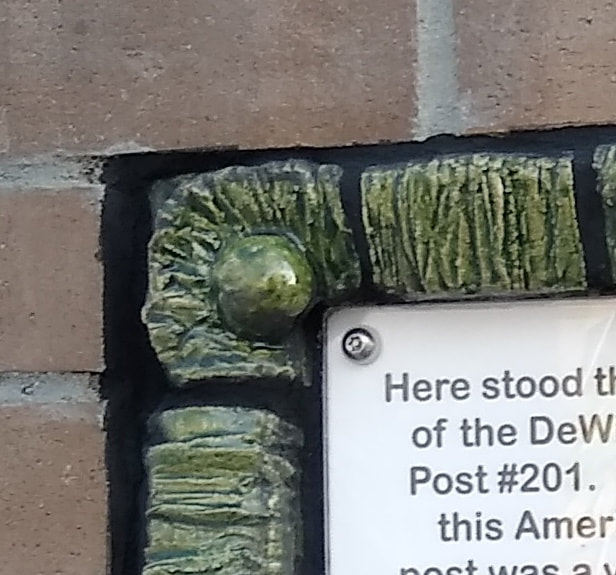- Home
-
Art
-
Public Art
>
- Seated in History >
- Climate River
- Coronado Seniors
- Colfax Ave. Bridge
- Terrain Art
- Nothing in the Desert
- Signifire
- Orange Villas
- 70th St. Trolley Station
- Crying Wolf
- Recipe for Friendship
- Solara
- Awards
- Talmadge Apartments
- Bench Marks
- Mayberry Townhomes
- Parkside Apartments
- Iowa Street Seniors
- A San Diego African American Legacy
- COMM22
- Mission Cove
- Social Circles
- Rosa Parks Memorial Transit
- Paradise Creek
- Saline for Insite
- SMart San Luis Rey Mission
- A-Where-Ness
- Los Vecinos
- Articles
- Studio Art >
-
Public Art
>
- Classes
- Eye Chanting
- Alzheimer's
- Stance Studios
- Journal Blog
- DONATE
- Art Map
- About
- Gang of Five
- Vineyards local
- Public Address
- Cultivate and Celebrate
- Warner Springs Trail Fest
- Warner Hub events/classes
I had seen some beautiful architectural clay work on a building in Long Beach. It was up high on top and I’m not even sure how/why I saw it, but it inspired this frame.
I designed the lay out of the words and image, but even before that, I had to find the portrait of DeWitt to photograph it nice and clear. A few phone calls and I found someone at the new location for Post #201 (the cook actually) in Lemon Grove who was willing to open the attic for me to explore. Within the crawl space of an attic that had insulation hanging, were a number of boxes. This is where many of the other images came from. Downstairs in the main hall, way in the corner far from the big screen TVs was the original oil painting. Since there really aren’t many veterans left from the time of the original building, they didn’t know why I was making a big fuss over this old painting. I explained. Took the photos I needed and thanked them for a great day.
So, how does an image surface become strong enough to live outdoors? Shout out to KVO Industries who made the photo and words in enamel, thats tiny tiny bits of glass fused by heat. In older cemeteries you can sometimes find photos of person at an earlier time. Those too are made with this enamel process, because without something very sturdy, we wouldn’t still be able to see it today.
Then I bought some special clay that had lots of grog in it which makes it very strong. I made a jig to roll the clay into. I made forming tools out of melamine (like countertop material cut on a bandsaw) and created the form and texture I wanted. It then goes into a kiln to a high temperature (cone 6 as I recall). This is first heat process is called the bisque firing and now its ready for the glaze. This is all very similar to your hand made dinner plates. In the photo you can see me painting on a thick red color. As its being fired for the second time it turns into green. So it’s not like paint at all where you can see what you are doing while you are doing it. This process takes a lot of experience.
I had formed the clay into tiles with large grout joints because I wanted the black grout to bring gravity to the piece. The corners have a medallion quality that supports the idea of DeWitt’s military service.
I consulted with the architect, Deborah Smithton and the contractor Sun Country Builders to make sure the plaque went in the best place. We placed it not too high so everyone could read it. We put it near the main art so one might be enticed to see all the history. The large window made it possible to see all of it. The San Diego Historic Society
(Historical Resources Committee) had given advice and their desires to make sure that future generations would know their local history, and so they are a big part of the team. All a team working together actually, so the brick veneer installer had to leave me a hole in the right location. Templates, timing and coordination.
The enamel is strong against most things, but since it was on a busy street we put a piece of plexi glass over it. Security screws hold that plexi in place.
Please don’t ever see a plaque on a wall the same again.
I designed the lay out of the words and image, but even before that, I had to find the portrait of DeWitt to photograph it nice and clear. A few phone calls and I found someone at the new location for Post #201 (the cook actually) in Lemon Grove who was willing to open the attic for me to explore. Within the crawl space of an attic that had insulation hanging, were a number of boxes. This is where many of the other images came from. Downstairs in the main hall, way in the corner far from the big screen TVs was the original oil painting. Since there really aren’t many veterans left from the time of the original building, they didn’t know why I was making a big fuss over this old painting. I explained. Took the photos I needed and thanked them for a great day.
So, how does an image surface become strong enough to live outdoors? Shout out to KVO Industries who made the photo and words in enamel, thats tiny tiny bits of glass fused by heat. In older cemeteries you can sometimes find photos of person at an earlier time. Those too are made with this enamel process, because without something very sturdy, we wouldn’t still be able to see it today.
Then I bought some special clay that had lots of grog in it which makes it very strong. I made a jig to roll the clay into. I made forming tools out of melamine (like countertop material cut on a bandsaw) and created the form and texture I wanted. It then goes into a kiln to a high temperature (cone 6 as I recall). This is first heat process is called the bisque firing and now its ready for the glaze. This is all very similar to your hand made dinner plates. In the photo you can see me painting on a thick red color. As its being fired for the second time it turns into green. So it’s not like paint at all where you can see what you are doing while you are doing it. This process takes a lot of experience.
I had formed the clay into tiles with large grout joints because I wanted the black grout to bring gravity to the piece. The corners have a medallion quality that supports the idea of DeWitt’s military service.
I consulted with the architect, Deborah Smithton and the contractor Sun Country Builders to make sure the plaque went in the best place. We placed it not too high so everyone could read it. We put it near the main art so one might be enticed to see all the history. The large window made it possible to see all of it. The San Diego Historic Society
(Historical Resources Committee) had given advice and their desires to make sure that future generations would know their local history, and so they are a big part of the team. All a team working together actually, so the brick veneer installer had to leave me a hole in the right location. Templates, timing and coordination.
The enamel is strong against most things, but since it was on a busy street we put a piece of plexi glass over it. Security screws hold that plexi in place.
Please don’t ever see a plaque on a wall the same again.






